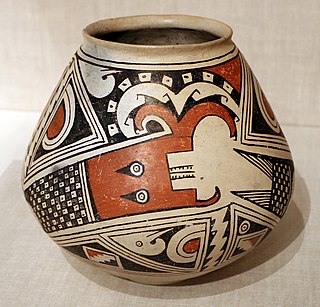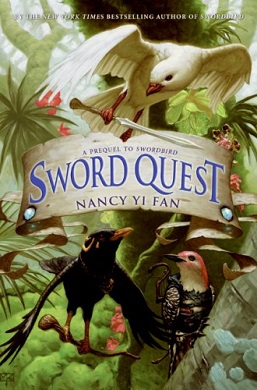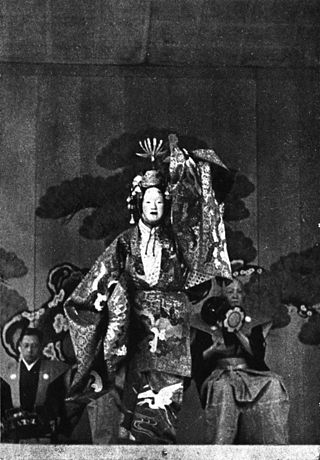Related Research Articles

The phoenix is an immortal bird that cyclically regenerates or is otherwise born again. While it is part of Greek mythology, it has analogs in many cultures such as Egyptian and Persian. Associated with the sun, a phoenix obtains new life by rising from the ashes of its predecessor. Some legends say it dies in a show of flames and combustion, others that it simply dies and decomposes before being born again. In the Motif-Index of Folk-Literature, a tool used by folklorists, the phoenix is classified as motif B32.

The Horned Serpent appears in the mythologies of many cultures including Native American peoples, European, and Near Eastern mythology. Details vary among cultures, with many of the stories associating the mystical figure with water, rain, lightning, thunder, and rebirth. Horned Serpents were major components of the Southeastern Ceremonial Complex of North American prehistory.

Cherokee spiritual beliefs are held in common among the Cherokee people – Native American peoples who are Indigenous to the Southeastern Woodlands, and today live primarily in communities in North Carolina, and Oklahoma. Some of the beliefs, and the stories and songs in which they have been preserved, exist in slightly different forms in the different communities in which they have been preserved. But for the most part, they still form a unified system of theology.

Mythology of the Haudenosaunee includes the creation stories and folktales of the Native Americans who formed the confederacy of the Five Nations, later the Six Nations (Iroquois). Historically, these stories were recorded in wampum and recited, only being written down later. In the written versions, the spellings of names differ due to transliteration and spelling variations in European languages that were not yet standardized. Variants of the stories exist, reflecting different localities and times.

The Indigenous peoples of the Americas comprise numerous different cultures. Each has its own mythologies, many of which share certain themes across cultural boundaries. In North American mythologies, common themes include a close relation to nature and animals as well as belief in a Great Spirit that is conceived of in various ways.

The golden pheasant, also known as the Chinese pheasant, and rainbow pheasant, is a gamebird of the order Galliformes and the family Phasianidae (pheasants). The genus name is from Ancient Greek khrusolophos, "with golden crest", and pictus is Latin for "painted" from pingere, "to paint".

In Slavic mythology and folklore, the Firebird is a magical and prophetic glowing or burning bird from a faraway land which is both a blessing and a harbinger of doom to its captor.

Raven Tales are the traditional human and animal creation stories of the indigenous peoples of the Pacific Northwest Coast. They are also found among Athabaskan-speaking peoples and others. Raven stories exist in nearly all of the First Nations throughout the region but are most prominent in the tales of the Haida, Tsimshian, Tlingit and Tahltan people.

Coyote is a mythological character common to many cultures of the Indigenous peoples of North America, based on the coyote animal. This character is usually male and is generally anthropomorphic, although he may have some coyote-like physical features such as fur, pointed ears, yellow eyes, a tail and blunt claws. The myths and legends which include Coyote vary widely from culture to culture.
Eric Darnell is an American animator, storyboard artist, director, screenwriter, songwriter and occasional voice actor best known for co-directing Antz with Tim Johnson, as well as co-directing and co-writing Madagascar, Madagascar: Escape 2 Africa and Madagascar 3: Europe's Most Wanted with Tom McGrath, as well as the spin off Penguins of Madagascar (2014) with Simon J. Smith.

Many references to ravens exist in world lore and literature. Most depictions allude to the appearance and behavior of the wide-ranging common raven. Because of its black plumage, croaking call, and diet of carrion, the raven is often associated with loss and ill omen. Yet, its symbolism is complex. As a talking bird, the raven also represents prophecy and insight. Ravens in stories often act as psychopomps, connecting the material world with the world of spirits.

Sword Quest is a 2008 children's adventure novel by Nancy Yi Fan. It is a prequel to Swordbird which was published in February 2007.

Hagoromo is among the most-performed Japanese Noh plays. It is an example of the traditional swan maiden motif.

In Australian Aboriginal religion and mythology, Crow is a trickster, culture hero and ancestral being. In the Kulin nation in central Victoria he is known as Waang and is regarded as one of two moiety ancestors, the other being the more sombre eaglehawk Bunjil. Legends relating to Crow have been observed in various Aboriginal language groups and cultures across Australia.
The Nachtkrapp is a South German and Austrian bugbear creature, cautionary tales about which are used to scare children into going to bed. Similar legends exist in Hungary, the Czech Republic, Poland, and Russia.
In Turkic folklore, Korbolko is a firebird. He brought fire to earth and taught the people to burn the fire.
Fairer-than-a-Fairy is a literary fairy tale published anonymously in the 1718 fairy tale collection Nouveaux contes de fées. It is attributed to the Chevalier de Mailly. Andrew Lang included it in The Yellow Fairy Book.

Julia Allison Clarke is an American paleontologist and evolutionary biologist who studies the evolution of birds and the dinosaurs most closely related to living birds. She is the John A. Wilson Professor in Vertebrate Paleontology in the Jackson School of Geosciences and a Howard Hughes Medical Institute Professor at the University of Texas at Austin.
Der Sohn der Teriel is a Berber folktale, first collected in Kabylia in German by ethnologist Leo Frobenius and published in 1922.
The Story of Princess Zeineb and King Leopard is a French language fairy tale published in the 18th century. The tale belongs to the international cycle of the Animal as Bridegroom as a subtype, with few variants reported across Europe.
References
- ↑ "Non-Historical Stories and "Prophesies" – Fiction and Fairy Tales".
- ↑ Van Laan, Nancy (1989). Rainbow Crow. Alfred A. Knopf. ISBN 978-0394895772.
- ↑ "Rainbow Crow". HitRecord.
- ↑ "'Crow: The Legend' Review: John Legend Leads a Musical Tale of Native American Mythology". Collider. 2018-11-15. Retrieved 2018-11-27.
- ↑ "Crow: The Legend". baobab studios. Retrieved 2018-11-27.